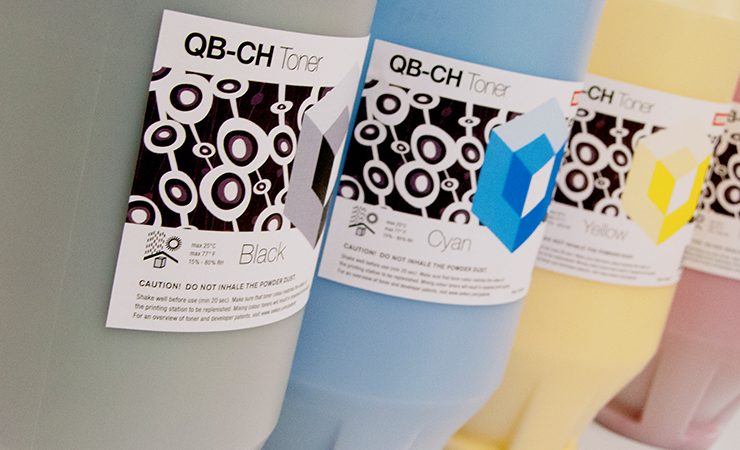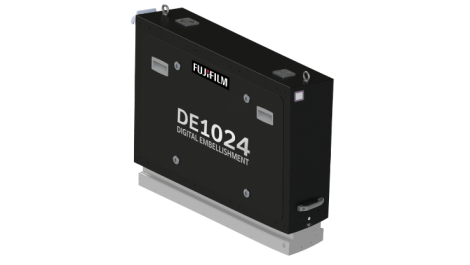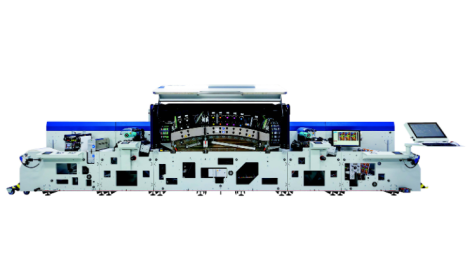Inks and toners form the message that informs, and hopefully attracts, consumers about the pack contents. This may include required important information about ingredients and how to use the product correctly and safely. By Sean Smyth.
Inkjet inks are low viscosity fluids, made into a colloidal suspension of pigment, ink vehicle, dryers and various additives to stabilise the components in dispersion, and in the case of water-based inks, helping to keep the nozzles open. In electrophotography, the toner may be a fine powder, or in the case of HP Indigo, a liquid. Toner formulation is proprietary to the particular press, but usually a powder toner is made up of a binder, a charge carrier and colourant with optional additives.
All have to perform in the press, print onto many substrates, dry and deliver the required printability and durability. There is a lot of material science and technology involved.
With a shine
Powder toner particles are typically 5 to 10 microns in size and composed of a polyester or styrene co-polymer binder (these are thermoplastic resins) with colourant, a charge control agent and often some metal oxide coating to optimise performance. They can be pulverised, where ingredients are mixed together at high temperature then ground to final size, or chemically grown in solution and then separated and dried as smooth particles.
HP Indigo ElectroInk is a liquid toner, where the colourant particles print from a low viscosity fluid on press. The vehicle is a resin dispersed in isopar (a high-purity isoparaffinic solvent) to form a paste into which pigment is dispersed in a bead mill. When the viscosity, shade, colour strength and fineness of grind is approved, further ingredients are added to provide the charging properties.
Highly concentrated ink is shipped in special cans (larger 15kg buckets in the case of white for the 20000 press) that are loaded directly into the press. There it is diluted with the isopar print oil to form a low viscosity fluid, which is monitored for optical consistency and recirculates in the press. An image is exposed onto the electrostatic plate (the PIP) and the liquid ink flows across the plate where the positively charged particles are attracted to the negatively charged image. The binary ink developer removes ink from the non-image area and passes it onto the warm blanket where the print oil evaporates and is efficiently recovered and recycled before the image is transferred onto the paper. Special colours are available to order, and there is an ink mixing station for customers to mix spot colours from the base inks.
HP Indigo has developed a new range of functional inks to help customers open new applications. There are overt and covert security toners, and a range of eye-catching fluorescent and metallic inks. After a disappointing initial launch, HP went back to the drawing board in developing a new silver ink, now providing fantastic results as DL&P readers will know from the January/February edition cover, which showcased the potential. Now the metallic ink combines new ink with a specially designed developer and developer roller for silver, and specific software for calibration with the correct maintenance crucial to achieve the best possible results. The seven-colour capability of HP Indigo label and packaging presses allows one unit to be dedicated to silver and a range of Pantone metallics can be achieved with a good level of lustre.
Addressing needs
Xeikon has developed its powder toner over the past few years, specifically addressing the needs of the labels and packaging markets. These include food safe formulations, lightfastness, one-hit opaque white and lowering the fusing temperature to save energy, which has the benefit of allowing more substrates (including PE) to be printed. Its Cheetah technology, in the CX presses, uses smaller particles than previous toners, aiding transfer at high speed, while lowering toner consumption, helping reduce consumable cost.
The company runs a toner competence centre joined by an inkjet competence centre, based in Lier. For the PantherCure UV inks, it looks at three performance indicators: applications, cost and speed. Xeikon said this translates into higher opacity whites, a broader colour gamut and other unique characteristics, including the new DuraCure technology. For dry toner, the developments concentrate on reducing the overall cost, through raw material selection and properties enhancing covering power, while pushing the boundaries of higher speeds.
Filip Weymans, Xeikon’s vice president of marketing, is keen to explain the food safety benefits of the toner, ‘Dry toner has, by nature, the unique opportunity to be the most food-safe digital solution. Xeikon has been fostering this and looked to the core component enabling us to be at the forefront. The latest QB toner technology is a good example as it addresses today already the upcoming legislation. Going forward we continue to explore the possibilities of dry toner based upon its unique values, for example colour swap on press is easily done (in inkjet this is practically impossible), meaning we are looking into broadening application range with custom toner with specific advantage. This can be in unique colour, specific reaction in certain environment, different appearances, different mechanical behaviour.’
In the printhead
The inkjet label and packaging sector uses water-based and radiation curing inks, with developments opening new applications and boosting performance. The ink technology has to perform in the printhead and press, with drying, and then on the pack or label during application, filling, in store and then throughout the life of the product – before end of life and recycling or disposal.
There are fewer special effect inks available, but white is being joined by special effect varnishes to add embellishment, while inkjet cold foiling is becoming mainstream. Four colour printing is being augmented with extended gamut process colours. Two of the early Landa press adopters, Edelmann and Graphica Bezalel have added extra print units to their S10 carton presses, while Screen has released a new blue ink for use its Truepress Jet L350UV+ label press. This widens the achievable gamut to let customers match a wider range of blue tones used on packaging.
Durst offers several ranges of inks for its UV inkjet presses. Its eight-colour Tau 330 RSC ink development focuses on flow and high edge sharpness, with good adhesion on substrates to DIN EN ISO 2409:2013, and its durability meets the marine immersion standard, BS5609, section 3. There is a low-migration set for primary food packaging, cosmetics and pharmaceuticals, as well as aluminium lids and folding cartons, formulated to meet the EuPIA guidelines and the Swiss Ordinance, and comply with the European Framework Regulation (1935/2004/EC) when utilised in compliant application and environment. These inks are manufactured according to Good Manufacturing Practices (GMP) for the production of products used in food packaging.
Based on water
There are real concerns about potential migration from UV inks, and the associated odour in some cases. Ink safety is not just for food. Tobacco and pet food are also critical, but brands in personal care, and tissue and hygiene products are probably even more demanding than food. Health and safety concerns apply in pharmaceuticals and this will spread into children’s toys, household and clothing, cosmetics and personal care products. Ultimately product safety is the responsibility of the brand, and more are looking closely at their supply chains, so the ink and varnish formulation is critical.
Durst has developed Water Technology, where water is used as a diluent with UV curing as a smaller part of the formulation. These inks are used in the single-pass corrugated machine, the Delta SPC 130, delivering high-quality print, with no odour and an abrasion-resistant, glossy, light-fast corrugated post-print.
Other vendors offer water-based inks, with product safety a major factor highlighted by Kodak and HP, among others. There are other issues with this type of ink, in achieving good printability on a wide range of substrates and ensuring good drying at very high throughput. This can be a problem for water-based inks, as the latent heat of evaporation of water (the energy needed to boil off the water) means a lot of power is needed for high performance systems. Water-based inks score well on print quality and compliance issues but drying and printability across the broad range of substrates need to be solved. Primers may be required for some papers and films, as manufacturers explore new formulations to improve all round performance on standard flexo and litho standards.
Ink and toner technology has come a long way. It is one of the key reasons that digital print is making headway into labels and packaging, and as ink makers deliver new formulations that open new applications as the capabilities improve.






